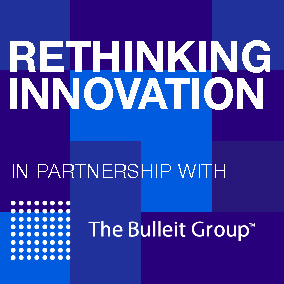The Bulleit Group 03 Sep 2019 // 2:25PM GMT

Every day we see the bounds of technology pushed farther with breakthroughs in research and applications of artificial intelligence (AI), virtual reality (VR), augmented reality (AR) and robotics across industries. Because these technologies have such potential to affect our day-to-day lives, it’s important they’re designed correctly to solve the right problems and integrate into our lives as seamlessly as possible. This is “design thinking,” defined by IDEO CEO Tim Brown as “a human-centered approach to innovation that draws from the designer’s toolkit to integrate the needs of people, the possibilities of technology, and the requirements for business success.”
Design thinking has brought us some of today’s most admired and coveted products—ever heard of the iPhone? How about a Tesla? It’s no coincidence then that some of the leading examples of boundary-stretching technologies happen to be also known for their novel and intuitive designs. In challenging the status quo, Apple and Tesla both created new, improved experiences that appealed to users’ emotions and unmet needs. Their legacies as innovators are intertwined with the clean, easy-to-use designs of their products.
At the core of design thinking is an empathy for the user that drives the creation of an experience that is exciting, useful, and accessible. This is true for both hardware and software products: Creating a physical product for the smart home, for example, may entail designing an object that improves some aspect of home life while fitting seamlessly into the backdrop of an average home. For a workplace software tool, it may mean tailoring the product to existing workflows and creating a low barrier to entry. In both cases, it’s about understanding, creating, and delivering a cohesive and intuitive experience.
Since the early 2000s, companies have adopted design thinking as a competitive advantage; being user-centric not only satisfies customers, but also keeps a company innovative, agile, and responsive to market demand. This is why PR professionals must consider everything we do through the lens of design: Once we understand how design factors into user experience and brand image, we are better equipped to tell stories that explain why certain products, technologies, and companies matter, and how they make our lives better, despite their unfamiliarity.
New technologies, no matter how alien, must have some element of approachability, otherwise they cannot succeed as sellable products. Many companies in the robotics industry have struggled greatly with this— fears of robots displacing human jobs and AI supercharging surveillance fill today’s headlines. But the reality is that there is no impending robopocalypse; applications of robotics across our homes, workplaces, and public spaces are keeping us safe, helping us complete our jobs more quickly and efficiently, and saving us the trouble of many menial tasks.
One robotics company that has managed to assuage our fears of robots has done so by applying design thinking: Cobalt Robotics, the maker of indoor workplace security robots, collaborated with design entrepreneur Yves Behar’s studio fuseproject to design a product that is accessible, unthreatening, and unobtrusive. With an exterior made of aluminium and fabric, Cobalt resembles a slender speaker more than a rigid cyborg. Every element of its appearance and functionality has been considered through the lens of easing people into the idea of robots in the workplace.
In terms of futuristic devices, a neural interface -- controlling technology with one’s mind -- is about as sci-fi as you can get. It’s something many people find off-putting, if not downright scary. To counter these fears and highlight the utility of their electromyography-based human-computer interface, startup CTRL-labs has focused on the device’s simple and attractive form-factor. Rather than a bulky cap full of wires and pointed electrodes, CTRL-labs has built a sleek wristband that non-invasively detects electrical activity from the surface of the skin. Designed specifically around human anatomy, it’s a reliable means of controlling virtual environments.
Just as it’s difficult to trust new products and technologies, humans innately associate strangers with danger. Yet the sharing economy phenomena has transformed our society into one in which everyone is constantly sharing, lending, and borrowing goods and services from strangers over the internet. Just a decade ago, the concept of staying at a stranger’s house instead of a hotel or opening up your home to a traveling stranger was unheard of; today it’s all the rage. Sharing economy platforms like Uber, Taskrabbit, and Turo have been able to enter the mainstream because they are designed to create community, which in turn inspires trust.
Today, over 2 million people stay at an Airbnb each night. Over the past decade, Airbnb has been at the forefront of a social shift, normalizing the idea of opening up your home to strangers. They’ve done so, according to Airbnb co-founder and Chief Product Officer Joe Gebbia, by implementing design thinking. The founders’ initial idea of a platform that offered short-term living quarters didn’t take off, so they put themselves into the shoes of real people, and learned that trust needed to be built first through meaningful interactions and effort.
To encourage meaningful interactions among hosts and guests, Airbnb nudges them to customize their profiles, send pre-booking messages, and leave each other reviews. The Airbnb brand is presented as a mediator between the two, encouraging friendliness, respect, and responsibility.
If applying design thinking is able to help us overcome our innate biases against robots, neural interfaces, and strangers, there’s no telling what else we can eventually become comfortable with. No matter how innovative or boundary-pushing a technology may be, it can succeed if it’s designed around and has empathy for the human user. As we talk about the ways in which tech is getting faster, better, and smarter, we can use design thinking to consider the best ways to tell the stories of how these technologies were developed and will affect us for years to come.
This article is part of a series exploring the topic of innovation in partnership with the Bulleit Group. You can read more from the series here.


































.jpg)

















